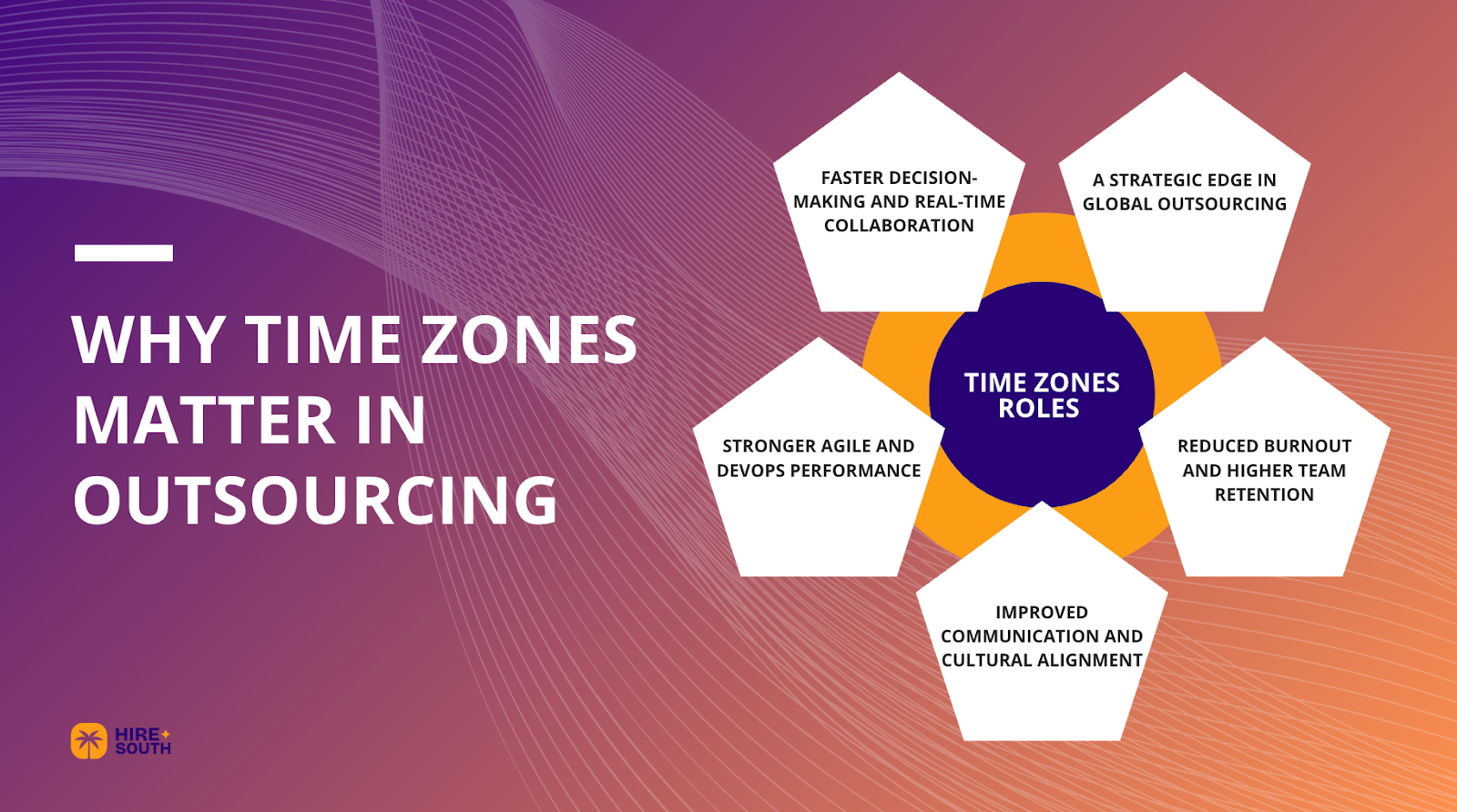When you outsource, getting the timing right is everything. And few regions align better with North American business hours than Latin America. With time zones overlapping up to 90% of the US workday, according to the World Bank, companies are finding that location isn’t just about talent, it’s about time.
Latin America’s near-perfect time alignment enables teams to collaborate in real-time, run agile sprints without delay, and make faster decisions. This small detail often becomes a major performance advantage, especially compared to regions like Asia, where 10–12-hour gaps can slow progress.
This article breaks down why Latin America's time zones matter so much when outsourcing. You’ll learn which LATAM countries share the best time overlap, how to choose the ideal zone for your strategy, and why time zone value is becoming a key factor in the global outsourcing equation. Keep reading to learn more!
Why Time Zones Matter in Outsourcing

Time zones play a larger role in outsourcing than most businesses realize. They influence how fast projects move, how well teams collaborate, and how effectively clients and partners communicate. When your team and your outsourced partner operate in similar hours, productivity naturally improves, meetings are more efficient, and decisions happen in real time.
Faster Decision-Making and Real-Time Collaboration.
One of the biggest advantages of time zone alignment is the ability to make fast decisions. When you and your outsourced team share working hours, you don’t lose a full day waiting for feedback or approvals. According to Deloitte’s 2024 Global Outsourcing Survey, 73% of organizations cite real-time collaboration as a top factor for successful outsourcing outcomes. Shared hours allow teams to solve problems immediately instead of sending messages that sit unread overnight.
Stronger Agile and DevOps Performance.
Agile and DevOps frameworks thrive on constant communication. Daily standups, sprint reviews, and bug fixes depend on real-time participation. When teams in Latin America share most of their workday with North American clients, projects stay synchronized and deadlines stay on track. In contrast, outsourcing across a 10–12-hour gap often leads to one-day delays for every small update, something that can quickly derail a sprint cycle.
Improved Communication and Cultural Alignment.
Communication doesn’t just mean exchanging messages, it’s about shared understanding. Teams that work in overlapping hours can hop on a quick call, clarify requirements, and adjust priorities on the spot. That responsiveness builds trust and accountability. Combined with the cultural and linguistic similarities across the Americas, Latin America’s time zones create a natural flow for collaboration that many Asian or Eastern European partnerships struggle to replicate.
Reduced Burnout and Higher Team Retention.
Time zone compatibility benefits people, not just projects. Employees working overnight or during odd hours to match a foreign schedule experience higher burnout rates. A Harvard Business Review analysis found that distributed teams with at least a four-hour overlap reported 35% higher satisfaction and stronger collaboration outcomes. In nearshore setups, professionals can maintain a healthy work-life balance while staying fully engaged with clients in real time, a win for both productivity and retention.
A Strategic Edge in Global Outsourcing.
If handled correctly, time zones can be a competitive advantage instead of a nuisance. Companies that choose outsourcing regions aligned with their own business hours gain more control, transparency, and responsiveness. In today’s global market, where speed and agility define success, the ability to work in real time can be the difference between scaling efficiently and falling behind.
The Value of Nearshore Time Zone Alignment
Working with nearshore teams offers one of the most underrated advantages in global outsourcing: actual time zone alignment. When your teams share similar working hours, collaboration becomes faster, clearer, and more efficient. You gain the benefits of outsourcing without the communication delays that come with working across the world.
A McKinsey & Company report found that companies with at least six hours of workday overlap between in-house and outsourced teams complete projects 23% faster on average. This level of synchronization allows for instant feedback, shorter development cycles, and quicker responses to client needs.
1. Seamless Collaboration During Core Business Hours:
Time zone alignment enables teams to work side by side during core business hours, even if they’re in different countries. This overlap lets you hold standups, planning sessions, and reviews without scheduling headaches. When a problem appears, it’s handled immediately, not the next morning. This real-time responsiveness builds trust, accountability, and momentum across teams.
Nearshore developers and professionals in Latin America typically work within one to three hours of major US time zones. That small difference eliminates the lag common in offshore arrangements, allowing both teams to move at the same pace.
2. Enhanced Communication and Project Transparency:
When you operate in shared time zones, communication improves naturally. Messages get answered in minutes, not hours. Quick alignment meetings replace long email chains. According to PwC’s 2023 Global Workforce Study, 67% of business leaders reported that overlapping time zones directly improved project visibility and reduced misunderstandings.
This transparency is especially critical for agile projects, where priorities shift rapidly. Being able to discuss blockers or roadmap changes in real time keeps teams aligned on goals and deliverables.
3. Better Productivity and Team Morale:
Aligned working hours also boost team morale. People can collaborate live without sacrificing work-life balance. Nearshore teams don’t have to work night shifts to sync with their clients, and that balance shows up in performance. Research from Harvard Business Review revealed that professionals working within compatible time zones are 31% more productive and 28% less likely to leave their roles due to burnout.
That continuity benefits you directly, experienced teams stay longer, institutional knowledge grows, and output quality remains consistent over time.
4. A Strategic Advantage in Nearshore Outsourcing:
Time zone alignment goes beyond convenience, acting as a strategic performance driver for remote teams that can find the space to collaborate in real time. It helps companies speed up product releases, strengthen cross-team collaboration, and maintain client satisfaction. When you outsource to a nearshore location like Latin America, you get access to skilled professionals who operate in sync with your business day.
Let;s Compare LATAM Time Zones to Other Outsourcing Regions
When evaluating outsourcing destinations, time zone compatibility is one of the most overlooked yet influential factors in overall performance. Latin America offers a unique advantage compared to offshore hubs like Asia and Eastern Europe: proximity to North America and overlapping workdays. This alignment shapes productivity, communication, and even employee well-being in measurable ways.
LATAM vs. Asia: Real-Time Collaboration vs. Overnight Delays.
Outsourcing to Asia, particularly India or the Philippines, often comes with a 10–13-hour time difference from US time zones. That gap limits real-time collaboration and forces teams to rely heavily on asynchronous communication. According to Gartner’s 2024 Global Outsourcing Report, companies working across non-overlapping time zones experience 35% longer project cycles due to delayed feedback and coordination issues.
In contrast, Latin America’s GMT-3 to GMT-8 range aligns almost entirely with US business hours. Teams in Mexico City or Bogotá can attend standups, review progress, and make decisions alongside US managers in real time. This overlap shortens iteration cycles, improves accountability, and keeps projects moving without overnight bottlenecks. For agile workflows, the impact is significant, with fewer context switches and faster releases.
LATAM vs. Eastern Europe: Collaboration Windows and Cost Balance.
Eastern European hubs such as Poland, Romania, and Ukraine have long been popular outsourcing choices for Western Europe. However, when compared to North America, the 6–8-hour gap often limits collaboration to a few hours per day. While quality and technical expertise are strong, scheduling alignment can become a recurring challenge.
Latin America, on the other hand, provides near-identical time zones to North American clients and partial overlap with Western Europe. A Statista (2024) survey found that 42% of US companies choosing nearshore partners in LATAM did so primarily for time zone alignment, while only 19% prioritized cost alone. That shift highlights a growing recognition that productivity gains and real-time communication often outweigh minor labor cost differences.
LATAM vs. Africa: Emerging Potential with Time Zone Gaps.
Several African nations, particularly Kenya, Nigeria, and South Africa, are emerging as outsourcing destinations. Their time zones, generally between GMT+1 and GMT+3, align better with Europe but are 5–8 hours ahead of the US This can create coordination issues similar to those in Asia for North American businesses.
Latin America, by comparison, offers true nearshore overlap, eliminating the need for night shifts or delayed correspondence. While Africa’s market is expanding rapidly, LATAM’s geographical and temporal proximity continues to make it more efficient for North American firms seeking seamless collaboration.
The Strategic Value of Time Zone Alignment.
Ultimately, what sets Latin America apart is not just cost or the immense talent, but synchronous communication. Real-time overlap allows companies to maintain the pace and quality of domestic teams while benefiting from nearshore scalability.
Where other outsourcing regions often struggle with long response times and fragmented coordination, LATAM provides a same-day workflow model that supports agile execution and faster delivery. In an environment where time-to-market defines competitiveness, that alignment becomes a measurable strategic advantage.
Ready to Start Outsourcing to Latin America?
Time zones aren’t just a logistical detail, they’re a strategic advantage. For US and European companies, Latin America’s near-perfect overlap of up to 90% of the North American workday, according to the World Bank, transforms collaboration, speeds up delivery, and reduces friction across projects. The result is higher productivity, faster response times, and stronger team cohesion, all key factors in modern outsourcing success.
At Hire South, we help organizations tap into that advantage by building dedicated nearshore teams across Latin America. Our approach focuses on operational alignment, real-time collaboration, and transparent delivery, helping businesses scale efficiently while maintaining control and communication. With experience across multiple LATAM markets, we bridge the gap between talent, time zones, and performance.
In a global economy where every hour counts, aligning your outsourcing strategy with the right time zone isn’t optional. We are here to ensure your teams work when you do, turning proximity into measurable results. Schedule a call to learn more about our staffing and outsourcing solutions!

Ready to Hire LATAM Talent?
Let us do the legwork to find your perfect remote hire in Latin America!




.jpg)


.svg)